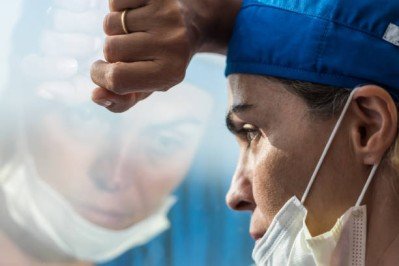While doctors are told to detach from their patients, they are never really trained or prepared for it.
“It’s a really huge tumour encasing the major arteries of the brain and circling both optic nerves,” I said to the family sitting in front of me. This is after I’ve been intently and repeatedly scrolling back and forth through the MRI images loaded on the computer in front of me. The growth was arising from the pituitary gland but had invaded into the nose below and brain above, chewing up the bone at the base of the skull.
Betty, who had come in with her mother, was 48 and rapidly losing vision. She was finding it difficult to look after her five-year-old daughter not only because of her deteriorating vision but also her decision making and executive functioning. “It’s probably due to the tumour pressing on the frontal lobe, which is responsible for these functions,” I said. “We’ll have to operate on this through the nose and by opening up the head simultaneously. It’s going to be a major deal.”
“Will she be okay?” her mother asked. “Of course,” I said, following it up with a laundry list of possible complications. Our interpretation of how any operation will shape up is often filtered through the lens of our own experience.
A few days later, two teams operated on her synchronously. The ENT surgeon put in an endoscope from below and then prepared the passage through the nose. The tumour looked right back at us – quite pale and deceptively well-behaved. But the moment we bit at it, it bled like a pig. The only way to control the bleeding in such cases is to briskly remove the tumour and we proceeded to do just that. We then opened up the head and removed the monstrosity from above, gently separating it from the arteries it was encasing and freeing up the optic nerves till we encountered the cavity in the nose.
Once we removed it completely, we could see right through from the brain into the nose and right up the nose into the brain, and with the radiant light of the endoscope shining directly onto the brain through the nose in a dark lit room, the skull looked like an art installation. The ENT surgeons then repaired the defect in the base of the skull to isolate the two compartments. This closure is the most crucial part of the operation.
The next day, Betty was alert and awake, could see better, and looked really happy despite being connected to tubes and pipes in the ICU, which we got rid of over time. Her mother was thrilled that she was ready for discharge within a week, but just the day prior to that, I noticed two drops of water trickling down the nose. It was no ordinary water leaking out but cerebrospinal fluid or CSF from the brain. My heart sank into that elusive pit in the stomach where it makes knots when disaster is around the corner.
“We have to repair this urgently by sealing the leak,” I said with certainness. “Another operation?” her mother questioned. I nodded; the longer we take, the higher a chance of getting an infection, and I wasn’t about to waste any time. We went back in and redid the closure, tracing a gentle stream of CSF meandering from the brain into the nose. But she developed an infection with fever – no ordinary infection but full-blown meningitis. She became drowsy, irritable, and almost comatose, but with the appropriate antibiotics over 3 weeks, we got her back in shape and she was discharged in pristine condition. Every day of those three weeks, we fought for her survival even when her family was convinced she wasn’t going to make it. She went home with a new vision – literally and philosophically. She was back to taking care of her daughter with gusto.
A month later, she landed up in the emergency department with severe headache and vomiting. The CT scan showed that her ventricles had blown up – a condition we call hydrocephalus – and worse, they were full of air, air that was seeping in from the nose into the head. More sophisticated testing confirmed it. The year 2021 was bad for nearly everyone, but for this family, it was just getting worse.
“We have to go back in and fix the problem,” I proclaimed, albeit a little helplessly. Why this had happened after such a meticulous closure was hard to fathom. Was there another area of the bone destroyed by the tumour that was sucking in the air? Was it the pressure of the hydrocephalus that was not allowing the seal to heal? Whatever needed to be done had to be done now, before it became too late. We took her back to the OT and put in an emergency tube to drain the fluid, re-repairing the leak even though we didn’t find the spot it was leaking from. But she wasn’t improving.
I was razed to the bone of my resilience; yet, I told them I wasn’t going to give up. “We’ll fight this thing together,” I told her forlorn family. I saw her four times a day, checked on her an additional eight times. After doing a few small operations to change the external tube, we did another operation to internalize the shunt tube and then another to set its pressure right.
After another month, the CT scans looked perfect and so did she. She started talking, eating alone, and walking with support. She asked about her child and gave instructions on how she should be managed at home. We cut a cake for her a day prior to discharge. The family was effused with affection. For our grit and her grace.
And the next day, she had a seizure; her head was full of air again. She was unconscious. We got another senior ENT surgeon to repair it but that closure didn’t work either. We tried once more a few days later. Three months and ten operations later, she was gone. And I still can’t get over it. It’s like the laceration of a heart that barely feels bearable.
Often in medicine, we are told to detach. But no one teaches you how. She was an appendage of my mind and body and it is impossible to forget her. The popular mode of thinking is, if you work hard enough and follow certain steps, we’re able to get over our losses. That might be true for most, but some losses don’t follow such models, and it was famous psychologist Pauline Boss who cautioned us on the nature of such loss: “Its ending is never perfect, even in the best of times.”
Patients sometimes leave, but how they leave always stays. And often, the illusion of closure is exactly what it is – simply a myth.
———————————————————————————————–
This article first appeared in the Sunday Mid-Day on 9th January 2022
https://www.mid-day.com/author-detail/Dr-Mazda-Turel-88





